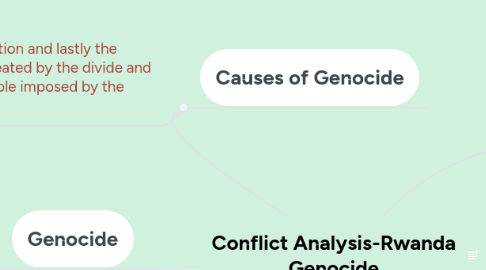
1. Historical context
1.1. 1300s - Tutsis migration into what is now Rwanda.
1.1.1. Late 1800s - Tutsi King Governed Rwanda.
1.2. Colonial Rule, Rwanda becomes part of German East Africa between (1899-1916).
1.3. Colonial rule, Belgium governed Rwanda from 1916 when Belgian forces occupy Rwanda to 1961.
1.3.1. The introduction of identity cards by the Belgium empire in 1935 to differentiate between the Hutus and Tutsis was a form of Social Darwinism.
1.4. Rwandan Revolution between 1957 to 1961.
1.4.1. Tens of thousands of Tutsi's exile into Uganda.
1.4.2. Extreme ethnic violence between 1964 and 1994.
2. Post Independence
2.1. By 1963 the Hutu majority led by the president Grégoire Kayibanda forced many Tutsis and opposition parties to leave the country.
2.2. President Gregoire Kayibanda ousted by Major Juvenal Habyarimana in 1973.
2.2.1. By the mid-1980s the number of Rwandan refugees in neighbouring countries has surpassed one- half million.
2.2.1.1. Habyarimana Rwanda enforces a single party dictatorship system.
2.3. In 1994 a Tutsi alliance known as the Rwandan Patriotic Front (RPF) invade Rwanda from Uganda in attempt to seize power.
3. Genocide
3.1. In approximately 100 days 800,000 Tutsi and between 10,000 to 30,000 Hutu had been killed in 1994.
3.1.1. In July of the same years the RPF and a moderate Hutu's formed a new government supported by the Arusha peace agreement.
4. Actors
4.1. Primary actors
4.1.1. The Rwandan Patriotic Front, the Hutu Governments, and Political Parties.
4.2. Secondary Actors
4.2.1. Neighbouring countries, Zaire (supports the regime), Uganda (supports the RPF) and Tanzania ( officially neutral).
4.3. International Actors
4.3.1. The United Nations ignored the genocide evidence and refused to act in a timely manner.
